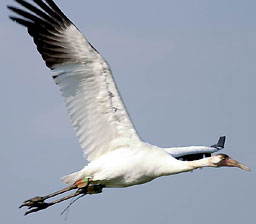
If you live along the migration route of the Whooping Crane shown above, there's a tiny possibility we might see this very rare bird someday during migration. In the above picture, notice that the above crane wears radio transmitters with wire antennae hanging from them. These transmitters enable researchers to know exactly which of the very few Whooping Cranes the above bird is. She is "Poe," officially known as DAR 28-05, and she was hatched in 2005. On the International Crane Foundation's "Class of 2005" page you can do a page search for the name Poe, and read what happened to her.
- Permanent residents, or just "residents," are non-migrating birds such as House Sparrows who remain in their home area all year round.
- Summer residents are migratory birds such as Purple Martins who arrive in your area during the spring, nest during the summer, and leave for warmer grounds during the fall.
- Winter residents normally nest in cooler areas, but spend winters in your local warmer location. For example, White-throated Sparrows, who are summer residents in much of Canada, are winter residents in much of the US.
- Transients are migratory species who nest in one location, then shift to another location, so you'll see them in your area only when they are "in transit," migrating. For example, American White Pelicans nest at certain spots in Canada and the northwestern US but overwinter from the southern US south into Central America. In Oklahoma, then, they're seen "just passing through," as transients.
Sometimes a bird species present in our neighborhood the whole year can also be migratory. The American Robin migrates, though in most of the US it can be seen year round. If you live in the central US state of Kansas, for instance, the robins you've seen all summer may migrate south during the fall, while robins who nested farther to the north may spend their winter in your area.
In general, in the Northern Hemisphere, the farther north you go and the more severe the winters become, the greater is the percentage of birds migrating south to warmer climes during the northern winter. It's been estimated that of the 215 or so species of bird nesting in the northern state of Michigan, about 90 percent migrate to some extent. More than 100 species who spend summer in the US completely leave the country to winter in the West Indies and/or Latin America.
WHY MIGRATE?
The main advantage of migration is easy enough to guess. During northern winters there's little food, and cold temperatures make life hard. Farther south, there's more food and less cold. Below, thousands of Snow Geese, Anser caerulescens, who nest in Canada, Alaska and Greenland beyond the timberline, gather during the northern winter in the US southern state of Mississippi.
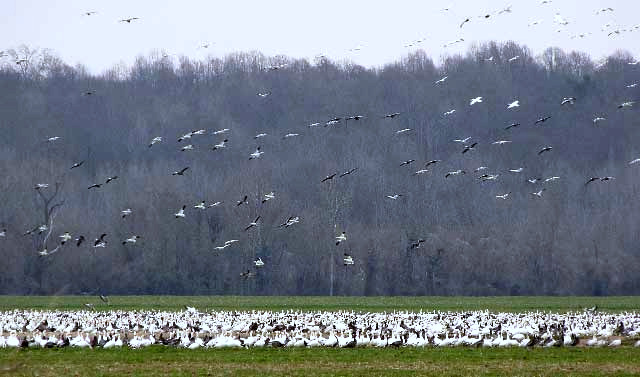
It's been shown that, at least in some bird species, changes in day length cause glands in the birds' bodies to produce hormones which produce profound changes inside the birds, changes that prepare them for migrating. In the fall, as days grow shorter, fat accumulates under the skin. This fat contains energy needed for coming days when the birds will be spending more energy flying than they'll be eating during their occasional rests. Weather changes sometimes trigger a migration's start, but by then the birds are already prepared. The urge to migrate must be very powerful. Starlings caged as their migration time approaches become extremely fidgety and point their bodies in the direction they want to fly toward.

Watching bird migration take place is one of the most exciting and interesting things a birder can do, and it's something you can see in your own backyard. At the right are White Pelicans, Pelecanus erythrorhynchos, seen over a backyard in central Mexico where they'd spent the winter, and now in late March were migrating back toward the north.
Especially in the spring when birds are in their bright courtship plumage and males are lustily singing, it's a pure joy to walk around taking note of which species have arrived. In the fall, as Northern-Hemisphere migrants head back south, they're much quieter and their plumage is more drab. They're harder to identify, too. Nonetheless, their passage is still a majestic event to behold.
MIGRATORY FLYWAYS
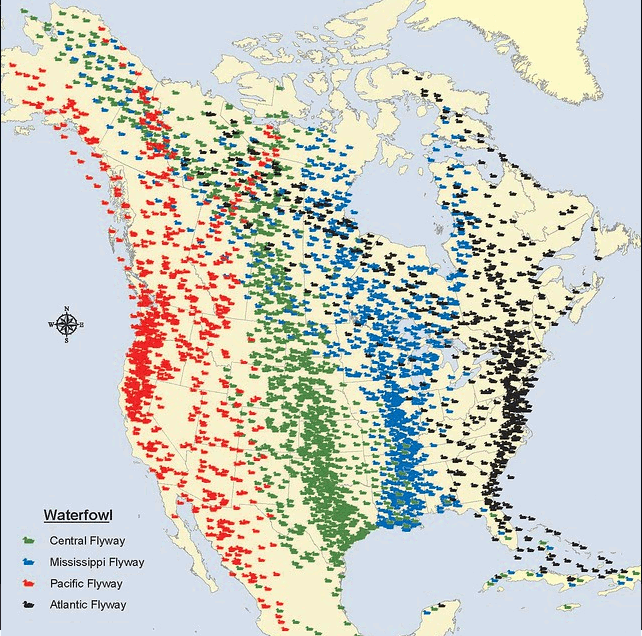
The above map shows the four waterfowl migratory flyways. A 2014 publication by Frank La Sorte and others reported that migrating land birds used only three major migration flyways: an eastern and western whose paths shifted westwards in the spring, and a central flyway overlapping with the eastern one, and constricting during the autumn.
When migrants start moving, they form broad, diffuse waves that merge into great "rivers" of birds. The passages north and south of different bird species occur at more or less predictable times. For instance, when spring's first Yellow Warblers, Setophaga petechia -- which winter from southern Mexico south to Peru and Brazil -- return northward each year, they reach southern California and southern Florida around April 1. By May 1, their "northern front" lies along a line running between Washington State and New York State. By June 1, they've reached the Arctic region of northern Canada.
BIRD BANDING
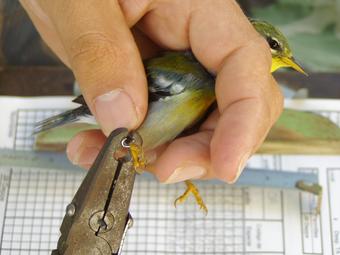 Banding a Northern Parula Warbler; image by Antonio Celis-Murillo, used courtesy of USGS Patuxent Wildlife Research Center
Banding a Northern Parula Warbler; image by Antonio Celis-Murillo, used courtesy of USGS Patuxent Wildlife Research CenterOrnithologists, or "bird scientists," capture wild birds, and on the birds' legs secure small metal bands bearing identification numbers and maybe more information, as shown at the right. Often the bands are brightly colored so they can be recognized from a distance as part of a particular study, and sometimes a bird is seen wearing more than one band. Information attained through bird banding was the main source of data enabling researchers to create the above flyway map, and later to fine-tune that map for land birds.
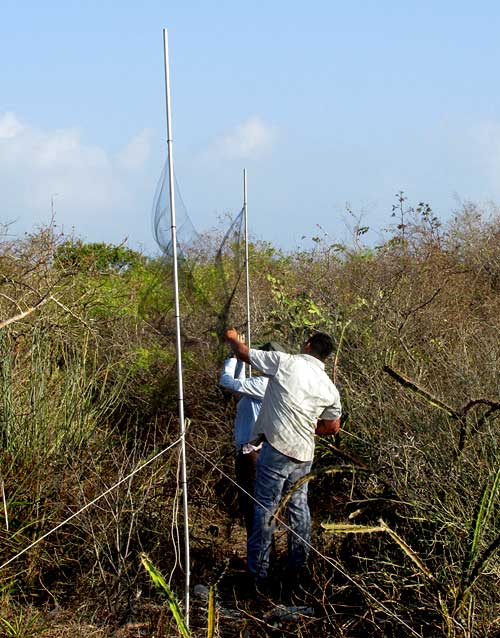
Bird banders normally capture their birds in filmy "mist nets" like the one shown at the left. In that one, erected in coastal scrub along the northern coast of Yucatán, Mexico, captured birds are being removed. The nets' black, monofilament nylon threads are so thin (about 0.08mm or 3/1000th inch) and hard to see that birds fly into them and become entangled. The mesh size is only about 15mm (19/32nd inch) across, so birds don't fly though them.
In fact, disentangling birds so they're not hurt accounts for much of the fieldwork of bird banding. Often insects such as grasshoppers and large beetles also are caught, and are almost impossible to release unhurt. Normally, bugs get sacrificed for the sake of science.
Sometimes after capturing a bird, nothing is done other than placing a band on the bird, recording the information, and then releasing it, hoping that someday someone with recapture the bird or maybe find it dead still with the band attached, and send information on the band to wherever the band's contact information says.
At other times, as when a study is being done on a specific bird species, as much information on caught individuals is taken as reasonably possible. This is happening below.
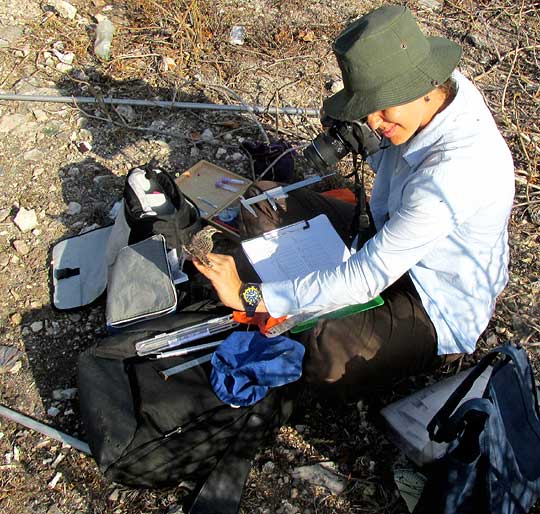
During the above banding operation, the birds were weighed, and measurements made of several parts, including beak length and toenail length. A feather was removed from each bird's tail and a tiny amount of blood taken for genetic studies to be done later. Since male and female Yucatan Wrens are practically indistinguishable, later each bird's gender would be determined with certainty by looking at chromosomes in the blood samples. Colored bands were clamped onto the legs, and the birds released.
